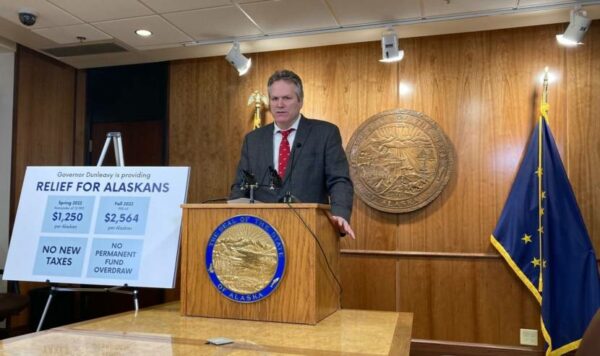
This year’s budget talks are getting underway in Juneau. With the recent rise in oil prices, Gov. Mike Dunleavy is once again pushing for a higher Permanent Fund dividend for Alaskans.
We spoke to Alaska Public Media and KTOO’s state government reporter Andrew Kitchenman to break down this year’s budget and PFD talks.
Listen here:
[Sign up for Alaska Public Media’s daily newsletter to get our top stories delivered to your inbox.]
KG: We’re in the middle of a bump in oil prices. A barrel of Alaska North Slope crude has been creeping toward $100. How is that influencing this year’s budget discussions?
AK: I’d say it’s having a big influence. But having said that, it’s almost surprising it hasn’t been larger, because we are talking about a large amount of money. Gov. Mike Dunleavy said in a recent news conference that all this money would lead to a surplus over the next year and a half, of more than $1.5 billion dollars. And that’s with all of his current proposals. So it’s very helpful for the governor’s position on, for example, the Permanent Fund dividend, that we have a projected surplus that would occur even with a PFD of more than $2,500. Now, the governor also acknowledges that oil prices always go back down. So he doesn’t want to rest the case for his policy proposals just on the high current prices.
KG: So is it accurate to say that there’s a surplus in the budget this year?
AK: It’s helpful to keep in mind that whether there’s a surplus or deficit is really determined by the whole budget year, because there’s always money coming in and coming out. And the budget year doesn’t end until June, and they don’t audit it until months after that. Having said that, the state has been bringing in a lot more money than it was projected to bring in. So when you project a balanced budget, sort of by definition, you appear to have a surplus when you’re bringing in more revenue than you expected.
KG: Gov. Dunleavy has warned that the price of oil will remain volatile. So why does this proposed budget seem to depend on oil prices staying higher than they have in recent years?
AK: First, I guess we could talk about how the administration projects the price. And that’s currently based on the futures market — that’s what people are paying for contracts to have oil delivered on a future date. The Department of Revenue has used the futures market since Dunleavy became governor. So it’s not a completely new thing. If anything, the forecasting method is a little more conservative since the fall than it was for the previous couple of years, when the state just assumed oil prices will go up with inflation after using the futures market for the next year. But now using the futures market for the long term, the price actually is projected to go down over time.
Part of the issue is the state has to pick a price, and it’ll build a budget around that price. It’s always gonna run the risk that if the price comes in lower, there’ll be problems.
KG: So under the governor’s current plan, what kind of PFDs can Alaskans expect this year?
AK: Well I’m hearing that it’s gonna be higher than the $1,114 last year. How much higher, would be speculation. Even if legislators were confident about oil prices, there may be some concerns that if the Legislature were to pay a big PFD this year, it would create pressure for unsustainably high dividends in the future.
I’m gonna throw a lot of numbers at you. One way of looking at it is what share of the annual draw from the Permanent Fund should be spent on PFDs. Some legislators want it to be a quarter of the draw. And that would mean a PFD of about $1,250. That’s about the average over the last 40 years for what it’s worth, without adjusting for inflation.
If it was a third of the draw, it would be about $1,660. That’s closer to the 40 year average, if you do adjust for inflation.
And some want it to be closer to about 40% of the draw, which gets you over the perhaps magical number of $2,000. I don’t know enough at this point to venture a guess as to what the final amount will be.
KG: The governor also wants a $1,200 payment on top of the PFD. How likely is that to pan out?
AK: That money is basically some extra money that would be on top of the PFD that Alaskans received last October, and it would make up the difference between what the governor wanted to pay last year and what they actually received. There’s been some skepticism from legislative leaders about this. They seen an advantage to running a surplus this year, because it would allow the state to replenish one of its savings accounts, the Constitutional Budget Reserve.
KG: A lot of this budget seems to hinge on federal relief money. How will major budget items be impacted in the future when that money isn’t available?
AK: To answer your question, I wish I had some infrastructure money to buy a crystal ball! Seriously, it’s really hard to answer, since Gov. Dunleavy moved away from large proposed cuts in the summer of 2019. It’s not been clear what it will take to balance the state budget in the long run. It’s part of why the PFD formula still isn’t resolved. The governor says the state can balance the budget with the PFD. He’s proposed no large new taxes, no large new spending cuts. But he’s baked in some assumptions, like lower than normal growth in Medicaid spending. That could be really difficult to achieve based on history. The outcome of this year’s election for governor and the legislature is going to have a large say over the long term impact.
KG: And what is the status of Alaska’s savings right now? And how is that playing into the discussion?
AK: Well, how do we define savings? In a sense, the Permanent Fund is savings. And it’s bigger than ever, it’s $81 billion. But if you think of savings as an account that you can spend money from at any time to cover near-term shortfalls, then the Permanent Fund doesn’t really fit, because there’s a law that’s supposed to limit the amount that the state draws each year.
The other big savings account, the Constitutional Budget Reserve, is only $1 billion. That’s a fraction of the state’s annual spending. So if anything, legislators working on the budget want to build up savings further and not spend them down.
Kavitha George is Alaska Public Media’s climate change reporter. Reach her at kgeorge@alaskapublic.org. Read more about Kavitha here.





